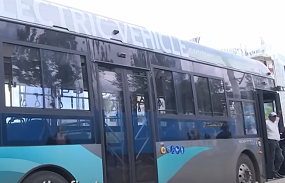By Henok Tadele HAILE – In the heart of East Africa, a green revolution is quietly unfolding. Ethiopia, a country blessed with an abundance of renewable energy resources, is embarking on a transformative journey. This journey promises to reshape its economic landscape and inspire a region-wide shift towards sustainable transportation and energy independence.
At the forefront of this revolution is Ethiopia’s ambitious electric vehicle (EV) policy, a bold initiative that is rapidly changing the face of transportation in the country while simultaneously addressing critical economic challenges. As the second most hydropower-rich country in Africa and tenth globally, Ethiopia is leveraging its vast renewable energy potential to power a cleaner, more
prosperous future.
The numbers are staggering. Ethiopia boasts an estimated 45,000 megawatts of untapped hydroelectric capacity, over 1.3 million megawatts’ of wind energy potential, and 10,000 MW of geothermal power. Not to mention the nearly limitless solar power potential. Yet, for years, these resources remained largely untapped, while the country grappled with a persistent foreign currency shortage exacerbated by an annual fossil fuel import bill of approximately 5 to 6 billion USD, according to some media reports.
Recognizing the need for a paradigm shift, the Ethiopian government introduced a comprehensive set of policies and incentives to accelerate EV adoption. The results have been nothing short of remarkable. Initially aiming to have 148,000 electric cars and 50,000 electric buses on the road by 2030, Ethiopia achieved this ambitious target in just two years, showcasing the policy’s resounding success.
This rapid transition is being further propelled by the impending completion of the Grand Ethiopian Renaissance Dam (GERD). As Africa’s largest hydroelectric power plant, the GERD is set to generate 15,000 gigawatt-hours (GWh) per year of clean, renewable electricity. This abundant supply of green energy will be a game-changer for Ethiopia’s efforts to electrify its transportation sector and
reduce its reliance on costly fossil fuel imports.
The GERD is the key that will unlock Ethiopia’s full potential in the electric vehicle revolution. With this abundant, emission-free power at its disposal, Ethiopia can accelerate a shift towards sustainable transportation and cement its status as a green energy powerhouse in the region.
The implications of this EV revolution extend far beyond Ethiopia’s borders. As the country reduces its dependence on fossil fuel imports, it is simultaneously positioning itself as a major exporter of clean energy to neighboring countries.
The surplus hydropower generated by the GERD and other renewable energy projects will allow Ethiopia to earn valuable foreign exchange by selling electricity to energy-hungry nations across East Africa. This virtuous cycle of renewable energy production and EV adoption is creating a ripple effect throughout the region. Ethiopia’s success story is inspiring other East African countries to explore similar initiatives, recognizing the potential for economic growth, energy independence, and environmental sustainability.
The Ethiopian government’s commitment to this green transition is evident in its recent policy decisions. The Ministry of Finance has announced tax exemptions for organizations importing and assembling electric vehicles domestically, further accelerating the shift towards e-mobility. This decision covers a wide range of vehicles, from public transport to household automobiles and freight transport vehicles.
Local industry is also playing a crucial role in this transformation. The recent inauguration of a state-of-the-art EV manufacturing facility in Debre Birhan, with an investment of 3 billion Birr and an annual production capacity of over 1,000 electric vehicles, underscores the country’s commitment to becoming a hub for EV manufacturing in Africa. This facility, along with others like it, is not only
creating jobs and fostering technological transfer but also helping to save foreign currency by reducing reliance on imported vehicles.
As Ethiopia continues to electrify its transportation sector, the lessons from its rapid EV adoption could serve as a blueprint for other African nations seeking to harness their renewable energy potential, improve urban air quality, and strengthen their economic resilience. The country’s journey towards a sustainable, electric-powered future holds promise not only for Ethiopia but for
the entire African continent.
By leveraging its abundant renewable energy resources and embracing the EV revolution, Ethiopia is charting a new course of sustainable economic development. As the GERD nears completion and the country’s EV ecosystem continues to expand, Ethiopia is poised to become a beacon of clean energy and sustainable transportation in East Africa, inspiring its neighbors and leading the way in the continent’s green energy transformation.
In the coming years, as more Ethiopians switch to electric vehicles and the country’s renewable energy capacity grows, we can expect to see a dramatic reduction in fossil fuel imports, improved air quality in urban centers, and a significant boost to the nation’s foreign exchange reserves. This transformation will not only benefit Ethiopia but will also contribute to the region’s efforts to combat climate change and achieve sustainable development goals.
Ethiopia’s electric vehicle revolution is more than just a shift in transportation; it’s a testament to the power of visionary policies and the strategic use of natural resources to drive economic growth, reduce environmental impact, and create a more prosperous future for all.
